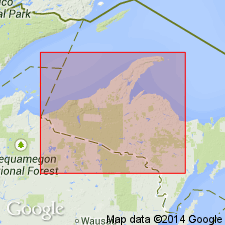
- Usage in publication:
-
- Bird iron-bearing member*
- Modifications:
-
- Original reference
- Dominant lithology:
-
- Iron-formation
- Chert
- AAPG geologic province:
-
- Lake Superior region
Summary:
Pg. 30 (table 1), 36. Bird iron-bearing member of Hemlock formation of Baraga group (new) of Animikie series. At Bird Exploration mine, consists of oolitic hematite-chert, highly ferruginous quartzite and schist, and breccia made up of angular chert and jasper fragments in a matrix of hard blue hematite. Member attains a maximum thickness of 300 feet and lies about 1,300 feet below the top of formation. Overlain and underlain by greenstone. Age is middle Precambrian (Animikie).
Named from exposures in trenches and test pits at the Bird Exploration [iron mine], in sec. 13, T. 43 N., R. 32 W., eastern Iron Co., Northern Peninsula, northwestern MI.
[GNC remark (ca. 1970): †Animikie series discarded (Cannon and Gair, 1970) and replaced with Marquette Range Supergroup. See also entry under Animikie.]
Source: US geologic names lexicon (USGS Bull. 1200, p. 346); supplemental information from GNU records (USGS DDS-6; Reston GNULEX).
For more information, please contact Nancy Stamm, Geologic Names Committee Secretary.
Asterisk (*) indicates published by U.S. Geological Survey authors.
"No current usage" (†) implies that a name has been abandoned or has fallen into disuse. Former usage and, if known, replacement name given in parentheses ( ).
Slash (/) indicates name conflicts with nomenclatural guidelines (CSN, 1933; ACSN, 1961, 1970; NACSN, 1983, 2005, 2021). May be explained within brackets ([ ]).

